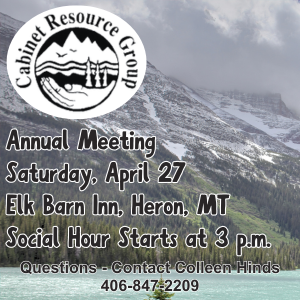Remember When?
April 29, 2021
THOMPSON FALLS
From Architectural and Historical Surveys
“Thompson Falls is the last town on the Northern Pacific railroad aspiring to be the outfitting point for the Coeur d’Alene mines,” wrote a correspondent to the Weekly Missoulian in April 1884. Because the railroad tracks beyond Thompson Prairie came closer to the mouth of Prospect Creek, eventual settlement occurred three miles west of the station along the bank of the Clark’s Fork River and near the waterfall that gave the settlement its name.
Knowledge of the Prospect Creek route attracted individuals to the site as early as the fall of 1883. Merchants arrived from Missoula to set up outfitting camps and eventually constructed buildings to take up residence. A group of these merchants, including John Russell and Peter McClinchy, formed McClinchy & Company and started building a wagon road along the Prospect Creek route.
The company sought and received a license from Missoula County in January 1884. This allowed them to collect a toll from road and ferry fees from Thompson Falls to the boundary line of the territory of Montana in the direction of the Coeur d’Alene mountains. By February the company placed front-page ads in the Weekly Missoulian advertising sleighs to the fields starting February 10, 1884.
Unlike their Belknap counterparts, these men were speculators and not town builders. They charged a good price for the use of their route: 50 cents for the ferry across the river, and then 25 cents for each saddle animal, 12.5 cents for each pack animal, 5 cents for each loose horse or cattle, $1.50 for each span of horses and wagon, and 50 cents for each additional span.
On the trail itself, former workers on the road established way stations. George Burson built Mountain House near the summit. A log hotel of two rooms, the sleeping room shared space with a bar and sitting room. The other room served as the kitchen and dining room. Fifty cents bought a night’s repose on a bed between two tiers of berths in which tamarack poles served as springs and pine boughs as mattresses. A fire burned without a stove or chimney in the room and the smoke lifted up and out of a hole in the roof. That is, unless it rained.
The popularity of the trail expanded Mountain House to include a store in a tent, two canvas lodge houses and three saloons by mid-1884. Further down the trail on the Idaho side, H.W. Kune established the Buckhorse House. And in late 1884, Zachariah Sales built Sunset House (also known as Half-Way House) on the trail. Sales used it as a rest station for his mail and stage service between Thompson Falls and Murray, Idaho.
By the early spring of 1884 over 30 businesses operated in the settlement. That number doubled in less than two months. As the mining excitement mounted, hauling teams and trains carrying merchants, merchandise and miners poured into the settlement.
That March, John Sharpe applied for a post office for the community and by the next month, J.H. Sinclair was named postmaster for Thompson Falls. A representative of Bell Telephone visited the town to raise subscriptions for a line to Eagle City, Idaho. A 23-car train decked with banners, advertisements and pictures arrived from the head offices of Glidden, Griggs & Company in Minneapolis, Minnesota, carrying $100,000 worth of groceries for its warehouse in the settlement. The Frontier Index, the town’s first newspaper, began circulation. Reports had Calamity Jane, “the Belle of the Black Hills,” walking the streets of Thompson Falls.
Gold sold for $18.40 an ounce and enough of it came out of the mountains for the trains to stop four times a day at Allen’s Station, across from the Hotel Thompson. Later that spring, the Northern Pacific Railroad agreed to build sidetracks, a freight house, and move the train depot into town from Thompson Prairie (Woodlin Flats, three miles west of Thompson Falls) in exchange for property to build the sidetracks on.
Population estimates of the settlement at this time vary. One traveler passing through wrote that Thompson Falls held “300 inhabitants and 30 saloons.” Another placed the population of the area, including South Thompson Falls, at about 2,000. (South Thompson Falls was the area immediately across the river from the town.) A more realistic figure for the area reported by a Weekly Missoulian correspondent gives a population of 600 or 700 in the town’s vicinity although “the shifting element that comes and goes during the week may swell the figure into thousands.”
At its height, the area may have contained perhaps 3,000 people, roughly 80 percent of which were transients.
Describing the people found in Thompson Falls at this time, the Weekly Missoulian correspondent wrote: “The population includes the rough-looking tramp, veteran prospector, sharp businessman, lively hotel keeper, land grabbers, gamblers, thieves, the hard character always abundant in new frontier towns, with a sprinkling of good law-abiding citizens who try to regulate its growth and advance its interests.”



Reader Comments(0)